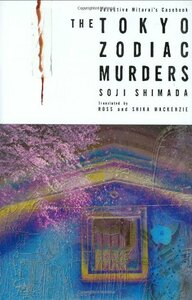Take a photo of a barcode or cover
challenging
mysterious
slow-paced
Plot or Character Driven:
Plot
Strong character development:
No
Loveable characters:
No
Diverse cast of characters:
No
Flaws of characters a main focus:
No
Такая скучная книга - я умудрилась заснуть в конце, прямо тогда, когда убийца раскладывал по полочкам свой гениальный план...
То, КАК именно провернулся трюк - супер. Не очень верибельно, правда, но с точки зрения именно теории - классная задумка. На практике, думаю, это маловероятно.
Многим не понравились описания разных японских городов, погоды и тд, но мне кажется, они очень к месту.
То, КАК именно провернулся трюк - супер. Не очень верибельно, правда, но с точки зрения именно теории - классная задумка. На практике, думаю, это маловероятно.
Многим не понравились описания разных японских городов, погоды и тд, но мне кажется, они очень к месту.
«токийский зодиак» Содзи Симада для меня этот роман на 4/5 (не исключено, что я могу однажды психануть и снизить оценку до 3 звезд).
в детективах мне важны несколько пунктов:
•интересный мотив
•преступление, которое невозможно раскрыть (сюда также относятся: загадочный преступник и вопрос «как, черт возьми, он это провернул?!»
•притягательный слог (по возможности)
с мотивом тут слабовато, зато метод преступления—ВАУ! после разъяснений детектива я зависла над схемой, ломая голову над тем, чтобы понять, как убийце удалось реализовать такую дикую головоломку, которую сорок лет не могла разгадать вся Япония.
про слог я неоднократно уже писала—он мне здесь совершенно не понравился. отложив книгу, мне не хотелось к ней возвращаться, хотя последние сто страниц я прочла залпом. но это не значит, что я больше не стану читать книги Содзи Симада—его уникальный подход к жанру меня все же заинтриговал.
в детективах мне важны несколько пунктов:
•интересный мотив
•преступление, которое невозможно раскрыть (сюда также относятся: загадочный преступник и вопрос «как, черт возьми, он это провернул?!»
•притягательный слог (по возможности)
с мотивом тут слабовато, зато метод преступления—ВАУ! после разъяснений детектива я зависла над схемой, ломая голову над тем, чтобы понять, как убийце удалось реализовать такую дикую головоломку, которую сорок лет не могла разгадать вся Япония.
про слог я неоднократно уже писала—он мне здесь совершенно не понравился. отложив книгу, мне не хотелось к ней возвращаться, хотя последние сто страниц я прочла залпом. но это не значит, что я больше не стану читать книги Содзи Симада—его уникальный подход к жанру меня все же заинтриговал.
medium-paced
An exceptional whodunit where the reader is given all of the evidence, clues and then the chance to solve the mystery for themselves before the big reveal. It has a real Jonothan Creek feel and whilst I didn't manage to solve every link in the chain I am proud to say I got quite a few. Must read for fans of a good murder mystery.
dark
mysterious
tense
medium-paced
Plot or Character Driven:
Plot
Strong character development:
No
Loveable characters:
Yes
Diverse cast of characters:
No
Flaws of characters a main focus:
N/A
Extremely fun classic murder mystery. I really enjoyed thinking about what could be the answer and I liked how you could figure out the answer by yourself (for the most part).
Okay, I don’t know what I was getting into when I started reading this, but seriously, wow. I mean, this may not be for everyone or for the faint. I think I was drawn in by the macabre ways of this storyline, yet intrigued by the ideology. It’s the way this “character” put together this entire plan in their mind. Honestly, I felt like it was such a trip. I know that it was all just fictional, but I can only imagine how many people out there have thought this way, or do think and feel this way. It’s terrifying. The fact that these are words written on paper to describe something so heinous is terrifying. The book focuses more on trying to solve this macabre mystery that happened back in the 30s. We then have a detective who, several, and I mean decades later, tries to continue and solve this case with a friend. The theories put together to solve the case are just all over the place, and even from the beginning, they start to make some sense. The dynamic between the friends was fun to follow. The ending, though, is hilarious because I didn’t figure it out prior to its ending. However, my mom called it before it even ended. She said it was so predictable. My mom loves these kinds of stories and is pretty good at figuring these thrillers out!
dark
mysterious
tense
Plot or Character Driven:
Plot
Strong character development:
No
Loveable characters:
No
Diverse cast of characters:
N/A
adventurous
challenging
dark
mysterious
sad
slow-paced
Plot or Character Driven:
Character
Strong character development:
Complicated
Loveable characters:
Complicated
Diverse cast of characters:
No
Flaws of characters a main focus:
No
Reading it the second time around, it's still incredible. Unbelievable. What a feast for the heart and the brain. I'd love to re-read it for the third time in a couple of years, after I've forgotten the whole story again.
Honkaku is a subgenre of Japanese Crime Fiction that came into being sometime in the early 1920's. The original definition was "a detective story that mainly focuses on the process of a criminal investigation and values the entertainment derived from pure logical reasoning". The term was coined to clearly differentiate Honkaku mystery fiction from other subgenres and it was used for both local and Western writers, although a distinct Japanese form became increasingly common in the 1950's.
Adding depth to long tradition, the author of THE TOKYO ZODIAC MURDERS, Soji Shimada has written over 100 mystery novels.
Knowing the background to the form isn't required to understand the structure of this novel, although it does help to realise that it is informed by such a rich tradition. Written in a number of parts or acts, THE TOKYO ZODIAC MURDERS firstly introduces the reader to a bizarre prologue - a note written in the mid 1930's by artist Umezawa outlining detailed plans and justifications for the murder of six of his daughters and nieces to create the figure of a supreme goddess Azoth. Disturbing and frankly very odd, the voice in this section is manic.
In the next part, 40 years on from the date of the note, the reader discovers that the six daughters referred to in the plan were indeed murdered, mutilated exactly as outlined. Which would have been a straight-forward case had one other daughter not predeceased her relatives, and Umezawa himself died before the girls. This is revealed as Kazumi Ishioka explains the background of the mystery that has baffled Japan since it occurred to his friend and self-styled detective Kiyoshi Mitarai. There investigation occurs in two parts from here - and along the way Mitarai accepts a threat / challenge which means that he must not only solve the puzzle, but do it to a schedule. To do that Mitarai and Ishioka travel through Japan, following where the clues lead them.
Those clues are laid out in a very traditional manner allowing the reader to discover them as the main detecting characters do. In an interesting touch the point at which the detective has solved the puzzle, the story switches to a note from the author letting the reader know that they now have everything needed as well. And it is actually solvable if you really pay attention, and take a logical and considered approach (this reader kind of worked out who, but admits it was more by good luck than good management, mathematical formula of any kind being the ultimate mystery after all).
Because the point of this style of novel is to present a puzzle, there's not necessarily a lot of character development alongside that, although the final resolution is markedly sad and moving. The detecting pair's travels around Japan do, however, give it a strong sense of place as well as many insights into the culture and customs of the country. The centrality of the Zodiac to the mystery does mean that some of the patterns - such as the dates of birth of the victims, the relationship of them to the structure of the Supreme Goddess to be built, and the layout of the closed room mystery in the murder of Umezawa are made more fathomable by the insertion of diagrams.
Puzzle upon puzzle THE TOKYO ZODIAC MURDERS is intricate and utterly fascinating, as an example of Honkaku and the culture from which it sprang, as well as providing sufficient puzzles to be solved to keep a reader happily occupied (and slightly confused) right to the last page.
http://www.austcrimefiction.org/review/review-tokyo-zodiac-murders-soji-shimada
Adding depth to long tradition, the author of THE TOKYO ZODIAC MURDERS, Soji Shimada has written over 100 mystery novels.
Knowing the background to the form isn't required to understand the structure of this novel, although it does help to realise that it is informed by such a rich tradition. Written in a number of parts or acts, THE TOKYO ZODIAC MURDERS firstly introduces the reader to a bizarre prologue - a note written in the mid 1930's by artist Umezawa outlining detailed plans and justifications for the murder of six of his daughters and nieces to create the figure of a supreme goddess Azoth. Disturbing and frankly very odd, the voice in this section is manic.
In the next part, 40 years on from the date of the note, the reader discovers that the six daughters referred to in the plan were indeed murdered, mutilated exactly as outlined. Which would have been a straight-forward case had one other daughter not predeceased her relatives, and Umezawa himself died before the girls. This is revealed as Kazumi Ishioka explains the background of the mystery that has baffled Japan since it occurred to his friend and self-styled detective Kiyoshi Mitarai. There investigation occurs in two parts from here - and along the way Mitarai accepts a threat / challenge which means that he must not only solve the puzzle, but do it to a schedule. To do that Mitarai and Ishioka travel through Japan, following where the clues lead them.
Those clues are laid out in a very traditional manner allowing the reader to discover them as the main detecting characters do. In an interesting touch the point at which the detective has solved the puzzle, the story switches to a note from the author letting the reader know that they now have everything needed as well. And it is actually solvable if you really pay attention, and take a logical and considered approach (this reader kind of worked out who, but admits it was more by good luck than good management, mathematical formula of any kind being the ultimate mystery after all).
Because the point of this style of novel is to present a puzzle, there's not necessarily a lot of character development alongside that, although the final resolution is markedly sad and moving. The detecting pair's travels around Japan do, however, give it a strong sense of place as well as many insights into the culture and customs of the country. The centrality of the Zodiac to the mystery does mean that some of the patterns - such as the dates of birth of the victims, the relationship of them to the structure of the Supreme Goddess to be built, and the layout of the closed room mystery in the murder of Umezawa are made more fathomable by the insertion of diagrams.
Puzzle upon puzzle THE TOKYO ZODIAC MURDERS is intricate and utterly fascinating, as an example of Honkaku and the culture from which it sprang, as well as providing sufficient puzzles to be solved to keep a reader happily occupied (and slightly confused) right to the last page.
http://www.austcrimefiction.org/review/review-tokyo-zodiac-murders-soji-shimada
dark
mysterious
tense
medium-paced
Plot or Character Driven:
Plot
Strong character development:
No
Loveable characters:
Complicated
Diverse cast of characters:
No
Flaws of characters a main focus:
No







